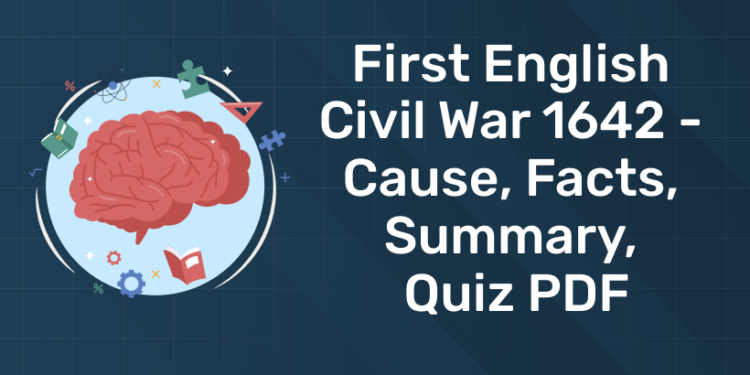Table of Contents
The English Civil War, took place between 1642 and 1651. It was a series of very violent fights and battles all across Britain. It was actually three different wars fought between two groups: the Parliament supporters called Parlimentarians and the king’s supporters called royalists. Both groups wanted to control the country. This article will cover everything about ”First English Civil War 1642 – Cause, Facts, Summary, Quiz PDF”.
First English Civil War 1642: History
On August 22, 1642, King Charles I gathered his army and flags in Nottingham. He started a war that split England into two sides. This war made families fight against each other, with brothers fighting brothers and fathers fighting sons. The main reasons for the English Civil War were ongoing arguments between Parliament and King Charles I. The king believed he had the right to rule without anyone questioning him, which led to even more disagreements.
Causes of The First English Civil War 1642
- King Charles’ Divine Right
- King Charles I ruled without Parliament, saying God gave him the right.
- He imposed heavy taxes, making Parliament members angry.
- People worried he wanted total control, so they met secretly.
- The ‘Short Parliament’
- In 1640, England split between those supporting Charles and Parliament.
- Charles asked for money to stop Scottish problems but Parliament refused unless he changed taxes and religion.
- Charles got mad and tried to arrest them, but they escaped, starting the war.
Life in Britain during the Civil War
- Common people were very poor, working in fields or mills.
- They lived in villages, working for landowners who gave them homes and food.
- The war made things worse, with many becoming refugees, but people helped each other by giving food and shelter to soldiers and refugees.
How the Civil War was Fought
- Cavalier vs. Roundhead
- Royal army (Cavaliers) and parliamentary army (Roundheads) were mostly common people enlisted by their masters.
- Both armies were untrained and poorly equipped at the war’s start.
- Deserters
- Initially, soldiers wore personal clothing, leading to frequent switching of sides.
- To prevent this, both sides later wore identifying sashes or armbands.
- The New Model Army
- Oliver Cromwell formed the ‘New Model Army,’ a professional and well-equipped force.
- This army wore a uniform for unity, greatly impacting the war’s outcome.
- Battle Tactics
- Battles occurred across fields, towns, and castles, often involving sieges.
- Warfare comprised Pikemen (spear carriers), Musketeers (gunners), and Cavalry (mounted fighters).
Famous Battles of the Civil War
- Major battles included Edgehill (1642), Marston Moor (1644), and Stow-on-the-Wold (1646).
- Cromwell’s victory at Marston Moor marked a turning point in the war.
First English Civil War 1642
The First English Civil War began in 1642, and Oliver Cromwell led the fight against the King. Eventually, in 1649, Charles I was found guilty of treason and executed.
During this time:
- Parliament passed a law stating that it must meet again within three years after it ends, showing that the King couldn’t shut it down without Parliament’s agreement.
- Oliver Cromwell took charge of the government from 1649 to 1660, known as the Commonwealth Government.
- Cromwell was called the English Napoleon and became known as the Lord Protector, a powerful leader.
Who Won The English Civil War?
- Parliamentarians, led by Cromwell, won after defeating King Charles I’s forces.
- Charles I was captured, tried, and executed, leading to the establishment of the Commonwealth.
- Cromwell ruled as ‘Lord Protector,’ and the monarchy was abolished.
Aftermath of The English Civil War
- Cromwell’s rule faced challenges, and upon his death, his son briefly took power before relinquishing it.
- Royalist support led to the Restoration, bringing Charles II back to the throne in 1660.
- Charles II ruled under parliamentary constraints, restoring the monarchy.
Interesting Facts about The English Civil War
- Comprised three separate wars, including a rebellion against Cromwell.
- Cromwell’s New Model Army was England’s first professional standing army.
- King Charles I’s attempt to arrest ministers in the House of Commons was seen as treason.
Summary of the First English Civil War 1642
Introduction:
The English Civil War happened from 1642 to 1651. It was a big fight between two groups: Parliamentarians and Royalists.
Why It Happened:
- Power Struggle: Parliament and King Charles I argued over who had more control.
- King’s Belief: Charles I thought he could rule however he wanted because he believed God gave him the right.
- Problems in Society: People had different beliefs and were struggling economically.
Important People:
- Parliamentarians: They supported Parliament and wanted to limit the king’s power.
- Royalists: They supported King Charles I and wanted to keep things the same.
Important Events:
- Start of the War (1642): The fighting began because tensions got too high.
- Charles I’s Trial (1649): Parliament arrested and punished the king for going against them.
- Oliver Cromwell’s Rule (1649-1660): He took charge and ruled as the leader.
How They Fought:
- Battles: They fought in different places across England.
- New Model Army: Cromwell’s army was well-organized and made a big difference.
What Happened Next:
- Parliament Wins: After the war, Parliament became more powerful than the king.
- Cromwell’s Time: He was a strong leader during the Commonwealth period.
- King Back: Charles II became king again in 1660 after Cromwell died.
Conclusion:
The English Civil War changed England a lot. It made Parliament stronger and changed how the country was run.
First English Civil War Quiz – Download PDF
First English Civil War Quiz
1. Who led the fight against the King during the First English Civil War?
a) King Charles I
b) Oliver Cromwell
c) James II
d) Charles II
2. When did the First English Civil War begin?
a) 1649
b) 1660
c) 1642
d) 1688
3. What was the fate of Charles I during the Civil War?
a) He was captured and executed
b) He fled to France
c) He remained in power
d) He abdicated the throne
4. Which legislative body passed a law limiting the King’s power to dissolve Parliament during the Civil War?
a) House of Commons
b) House of Lords
c) Long Parliament
d) Short Parliament
5. What title was given to Oliver Cromwell during his leadership after the Civil War?
a) King
b) Prime Minister
c) Lord Protector
d) Chancellor
Answers:
- b) Oliver Cromwell
- c) 1642
- a) He was captured and executed
- c) Long Parliament
- c) Lord Protector
Frequently Asked Questions
Who fought in the English Civil War?
The war was fought between two main factions: the Royalists (supporters of King Charles I) and the Parliamentarians (supporters of Parliament’s authority). The Royalists were known as Cavaliers, while the Parliamentarians were called Roundheads.
What were the major battles of the English Civil War?
Some major battles of the English Civil War include the Battle of Edgehill (1642), the Battle of Marston Moor (1644), and the Battle of Naseby (1645). These battles were pivotal in determining the outcome of the war.
How did the English Civil War end?
The English Civil War ended with the defeat of King Charles I’s forces by the Parliamentarians. Charles I was captured, tried, and executed in 1649. This led to the establishment of the Commonwealth, with Oliver Cromwell as ‘Lord Protector.’
What was the long-term impact of the English Civil War?
The English Civil War had far-reaching consequences, including the temporary abolition of the monarchy, the establishment of parliamentary supremacy, and the shaping of England’s political landscape. It also paved the way for the modern constitutional monarchy in Britain.













